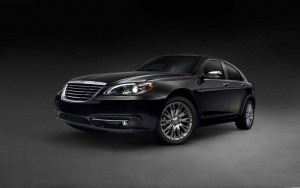
Chrysler is investing $1 billion in Sterling Heights to produce future midsize models, like the 200. The plant was originally set to close in 2012.
It’s been a busy – and costly – week for Chrysler, which has announced nearly $2 billion in investments aimed at updating an admittedly outdated and problem-plagued line-up.
Among the two key spending programs announced in recent days is a $600 million investment in an under-utilized assembly plant in Belvidere, Illinois, where Chrysler is expected to begin producing a new small car late next year. Based on the little Alfa-Romeo Giulietta produced by its Italian affiliate, Fiat Automotive, the new offering is expected to get 40 miles per gallon. (New small car will permit Fiat to up its stake in Chrysler; Click Here for more.)
The automaker has been releasing a series of updates on its revised product line-up, in recent days, with models like the Dodge Avenger and various Chrysler minivans getting some interior tweaks and additional technologies designed to enhance their appeal. But the new investments only underscore that the real breakthrough promised by Sergio Marchionne, CEO of both Chrysler and Fiat, is still just in the making.
Not that it would come a moment too soon, as Consumer Reports made clear this week.
The maker’s director of auto testing, David Champion, could find few good things to say about the smallest and most troubled of the Detroit automakers.
“Chrysler is the one area of the domestics that hasn’t improved,” said Champion, revealing the results of its latest automotive reliability study, which is based on responses from 1.3 million American motorists. The makers products scored mostly below average, with only the Dodge Ram 1500 pickup winning CR’s coveted “Recommended Buy” endorsement.
(Click Here for more on the Consumer Reports reliability study.)
Nonetheless, like a number of automotive media – including TheDetroitBureau.com – Consumer Reports has been offered an inside look at some of the upcoming Chrysler products, giving Champion and his colleagues reason to be optimistic.
“They seem to have a different mindset to build a quality vehicle,” he told the Detroit Automotive Press Association.
The Ram 1500 truck, the generally well-reviewed 2011 Grand Cherokee, the new Chrysler 200 compact and the various other models undergoing modest updates over the next year were, for the most part, the products of the old regime. They were developed under former owners Cerberus Capital Management, the equity funding giant that got in way over its head and seemed only interested in cutting costs, whatever the impact.
But far bigger changes are coming – albeit slowly.
The December launch of the Fiat 500 is the first sign of the new direction, the first product of the new alliance developed in Italy for sale in the U.S. In an unusual move, Chrysler is moving in the opposite direction of its Big Three domestic rivals, expanding its brand line-up with a new Fiat channel and splitting the Dodge truck side off under the Ram brand name.
But going forward, the typical consumer may not immediately recognize the way Chrysler will be steadily relying on Fiat more and more for the underlying “architectures” that will be used for many of its products, including the next-generation 200 and the eventual Dodge Avenger replacement.
While an Alfa platform will be used for the small car coming out of Belvidere, Chrysler will be more closely linked to another Fiat brand, Lancia. Its smaller models will provide the underpinnings for future Chrysler and Dodge models here. And Chrysler will provide the larger platforms Lancia will use in Europe and other parts of the world.
Platform sharing provides a way to expand global economies of scale. Nonetheless, the transformation won’t be cheap, as this week’s investments underscore. Not only is Chrysler spending $600 million in Illinois, but it is dropping $850 million into one of its oldest and most outdated assembly plants, the Sterling Heights plant, in Detroit’s northern suburbs.
That factory was originally slated to close, in 2012, as part of Chrysler’s post-bankruptcy reorganization. But Marchionne has decided to use it produce those next-gen midsize models, which will use Fiat’s C-EVO architecture. They originally were slated for production in Mexico or Canada.
Meanwhile, Chrysler’s engine plant in Dundee, Ohio, is getting a new $150 million injection – on top of an earlier, $179 million investment announced last December. It will allow the maker’s so-called World Engine factory to produce Fiat’s innovative Multi-Air 1.4-liter powertrain. That, in turn, will be shipped to Toluca, Mexico for use in the Fiat 500. But it could also find applications in other Fiat and Chrysler products later on.
Still more big investments are likely, according to industry and Chrysler sources. The Detroit carmaker has to revamp virtually every model in its line-up. That alone won’t be cheap. But it will also require the transformation of its manufacturing base into a much more flexible system able to seamlessly integrate with Fiat’s global production network.
It’s a good thing the Italian maker is solidly in the black – expecting to earn 2 billion Euros for all of 2010. It’s going to take some serious bucks to bring Chrysler back to life.
